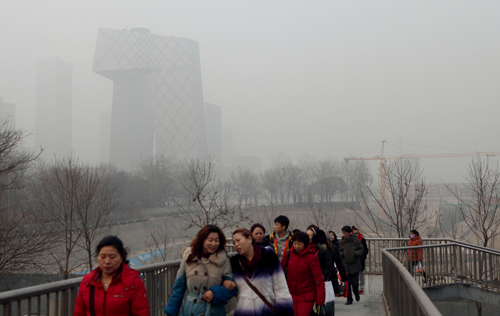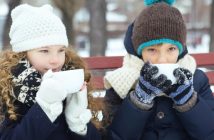There are few health experts we trust more than Dr. Richard Saint Cyr, a former health columnist for beijingkids and a board-certified family doctor at Beijing United Family Hospital. However, his greatest contribution to the health field is arguably his peer review-certified blog, My Health Beijing (www.myhealthbeijing.com), where he continually tests and reviews independent test results on air purifiers, pollution masks, and other clean air accessories. We contacted him again to recap the latest research on air pollution and health.
What does the scientific literature tell us about the effects of air pollution on health?
The World Health Organization’s air quality guidelines make it very clear: out of the many air pollutants, PM2.5 causes the most serious health risks, especially from long-term exposure. With children, whose lungs keep growing until around age 18, pollution can permanently decrease lung function. Short-term pollution spikes can cause sudden deaths in sick people, especially those with heart or lung disease.
The WHO is very clear about keeping PM2.5 levels under 10 µg/m3 [micrograms per cubic meter of air]– equivalent to a US AQI of 50 – at all times both outdoors and indoors, where we spend 90 percent of our lives. Last year in Beijing, the average was around 80 µg/m3. For comparison, the worst area in the USA around Los Angeles had an average of 18 µg/m3.
Another important study from the USA proved that health improved when the air improved. That’s very encouraging. This doesn’t mean you have to move to Antarctica – you just have to seriously tackle indoor air. It’s crucial to have at the very least an air purifier in each bedroom, where we spend a third of our lives. If your office or school isn’t doing enough [about air pollution], you have every right to kick up a fuss.

Tell us about your own family’s procedures for dealing with air pollution.
I’ve spent almost ten years in Beijing using and testing dozens of air purifiers and masks, trying to make my home safe for my my wife and my two boys, both under 3 years old.
We currently have six air purifiers – each one costing under RMB 1,000 – to cover each bedroom, the front room, hallway and kitchen. We have a couple of air quality monitors we keep on all the time, which I monitor using an app; it allows me to fine tune the machine speeds and keep our indoor PM2.5 [levels]close to my goal of 10 µg/m3.
We also seal the doors and windows, which helps a lot but sometimes raises CO2 levels. That’s why we open the windows any time the air is better. We keep our air purifiers on all the time, except maybe for those all-too rare days when the AQI is under 50.
We usually curtail walks and outdoor play when the AQI creeps over 200 and certainly over 300. I’d love my kids to wear their masks outside, but right now they just rip them off!

Many readers persist in running or cycling to work with a mask on when it’s polluted, believing that the benefits of physical exercise will outweigh the negative effects of air pollution exposure. Are they correct or just being reckless with their health?
Yes, the good news is that outdoor exercise and biking to work generally provides much more benefit than harm, especially from improved heart health. The best study was from older women in Shanghai and another study done mostly in Europe; both showed that [the health benefits from cycling to work]greatly outweighed the risks from pollution. Having said that, it’s still a good idea to wear an N95 mask – probably with an exhalation valve – any time the AQI is over 150 and certainly over 200.
What new products can you recommend that have come onto the market in the past year?
The biggest breakthrough last year was the new generation of air quality monitors – especially the Laser Egg – which are finally considered relatively accurate at a decent price point. Many more such devices are coming this year, and this is a great development.
Another important development is the increasing availability of more affordable indoor air purifiers. A lot of consumer-friendly masks continue to flood the market, but it’s important to use masks with government certifications and independent test results. That means a US NIOSH certification of N95 or N99, European certification of FFP2 or FFP3, or Chinese certification of KN95 or higher. After all these years, I still use and recommend the most evidence-based masks from the world’s most reputable mask company for many decades: 3M.
How can you test if your pollution mask is working properly, especially on small children?
Unfortunately it remains very difficult to test masks. A bad seal is sometimes easy to spot, especially if you wear glasses like I do. Most air leakage occurs around the nose and the chin, so if you feel any windy drafts, fogging or smells, it’s probably a poor fit.
If you truly want to know how good your mask is, you need to use an official machine like the TSI Portacount, which does two-minute quantitative fit tests of actual masks on people’s faces, in real-world situations like talking and moving your head. These fit tests are what construction companies must legally do for higher-exposed employees in the USA. Almost no such testing devices are available in China, but this is potentially a very useful service for people here, from consumers to construction workers. Wouldn’t you like to know whether your child’s mask actually works? I certainly would.
How would you like to see to make the clean air market become more transparent for consumers?
I long for the day when the WHO will come out with specific advice on pollution masks. At what AQI should we wear them? How much do they actually decrease risks? Who should wear them, when and for how long?
It’s incredibly frustrating that we still have almost no evidence-based data on wearing masks, especially for children. There should be much more government regulation, as far too many people in Beijing are wearing masks that have no independent or government proof of effectiveness.
The data is only slightly clearer for indoor air purifiers, but since we spend most of our lives indoors, people should be focusing on indoor air protection, where it’s now much easier to assess whether your air is clean.
This article originally appeared on page 54-57 of the beijingkids March 2016 issue. Click here to read the issue for free on Issuu.com. To find out how you can get your own copy, email distribution@truerun.com
Photos: Steven Jiang 1221, Nicolo Lazzati (Flickr) and Courtesy of Dr. Richard Saint Cyr




